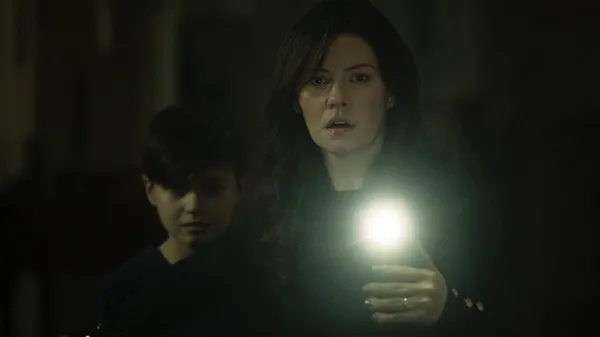 |
| Dylan Fitzmaurice Brady and Elisha Cuthbert in The Cellar |
If you read a lot my work here at Eye For Film, you’ll know that I have ongoing concerns about people moving house in horror films. It’s almost never a good idea, and it doesn’t work out well for the characters in Brendan Muldowney’s The Cellar, who also need lessons in not going into dark places on their own, not playing mysterious old gramophone records and not discounting mysterious symbols in their new home as decorative quirks. If this sounds like pure cliché, however, you’ll be surprised by how scary it is. The film didn’t make it into Glasgow Frightfest for nothing. It subsequently enjoyed a cinema run and it’s now opening on Shudder, so Brendan and I connected and I asked him about his aims when it came to making tropes which feel familiar frightening again.
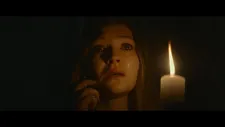 |
| The Cellar Photo: Courtesy of Glasgow Film Festival |
“You know, it's interesting you say that,” he responds, “because the short film it’s based on, The Ten Steps, that was inspired by Robert Wise’s The Haunting – not directly, although having said that there is a homage in this – and yet, what I wanted to do with that film was two things. I wanted to create a film that was all atmosphere, no gore, and I know that I use plenty of jumpscares in this film, in The Cellar, but in that film, The Ten Steps – it’s a very short film – I did deliberately set out to have a jumpscare at the start. So that the audience was expecting jumpscares, and then I wanted to just hit them with this ending that they weren’t expecting because they were expecting jumpscares. So there was a real deliberate plan to the short film.
“Then when I started with The Cellar, what I decided was, look, I'm going to have fun with the tropes, and hopefully put my own spin on them rather than calling them just pure homages. Like, you know, there's a ball in there – and some of them are subconscious actually – but it has since been pointed out to me that The Changeling had that. I've seen The Changeling years ago. I grew up in the Seventies watching Hammer movies and stuff like that on TV. I would have probably forgotten about that, but I googled it on YouTube because I wanted to just remind myself of the scene, and I found a video that said it’s the scariest bouncing ball in a horror film. So it's a really well used trope. But I would stand by it and say that we use it in a different way, in that it's part of the whole dimension of The Cellar and we're using it to illustrate that really.
“But yes, some of some of them are subconscious, and some of them are just there because they're great. Like even, say, Final Destination is so superb in the way it creates a creeping presence, that it's just hard not to work with the same type of camera moves and things. I love working with that stuff. I love working with practical stuff on set, like hair dryers blowing and doing stuff like that. Flickers of the lights. I find it really sort of like, the fun of filmmaking.”
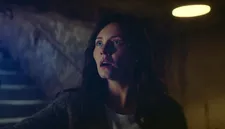 |
| Elisha Cuthbert in The Cellar |
It strikes me that because he’s using those familiar tropes, people think that they know where the story is going, so he can misdirect them as he did in the short.
“Yes, in the short, that's what I was doing in a way. The short was all about creating an expectation of what you're going to see and then doing it in a different way, a more cerebral way. In this I just knew I can't do that again. I've got to deliver some fun and fireworks. I suppose I was hoping that I might have some tricks in there that maybe weren't expected. And I do – without, you know, giving spoilers away – I do like the last act. Because I like when someone decides to take something somewhere and just goes all the way with it. I mean, I did have a version that became a full on monster mash-up, full of Hieronymus Bosch creatures and everything. It was just too expensive to do but it would have been really good.”
I suggest that it could make a good DVD feature, if he has sketches, and he agrees.
I tell him that the thing which really sold the film for me, early on, was Abby Fitz’s performance as the teenage daughter of the family, who has to descend the cellar steps in the dark after a fuse blows, because she carries terror so well. How did he find her?
“Because of Covid I found her through self tapes,” he says. “We had a brilliant casting director and she would have sent me 10 or 15 self tapes. And then we might have built a zoom session. But Abby quite quickly started to shine through. I mean in probably her first self tape or her second one, she was crying. And I've made a few films now so it's not as if I'm so impressed when I see an actor crying because they all have their own different ways of doing it, but Abby seemed to be able to tap into an emotion that was deeper than crying as well – very easily. So I knew that that was going to help things. In fact, really my only challenge there was was was containing it, keeping it just under wraps so that it didn't come out too early.
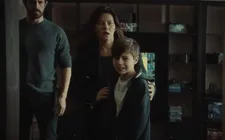 |
| Family time in The Cellar |
“It's such a strange thing to be reshooting a short film, because there's moments where I’m standing there and it's 16 years later, and I'm so different as a person, I'm older, and and I'm just looking for things that are the exact same as what happened before. And I remember Jill Harding was another great actress that I found in a small acting group or acting class before, and Abby reminded me of her.”
One of the other major characters, of course, is the house itself. How did he find that?
“You know, one of the financing structure was, we had a funder which basically incentivises decentralisation from Dublin. So if we shoot in one of the seven counties in the west of Ireland, we will receive some of our funds. They don't just automatically give it. You have to apply and it's a competitive process. But everyone was choosing the counties on the coast, the counties that had beautiful beaches and things. We didn't need that. They also said that County Roscommon wasn't getting enough love. But actually, before that had happened, we had been looking in County Sligo, and I had seen about ten houses and they weren't suited. They were either too big, like a palace, or they didn't have what I was looking for, which was a corridor.
“What I was really looking for was a corridor with a door that had a cellar. And very quickly, I realised I was never going to get the cellar: it was going to be a studio build. But I still wanted to have a long corridor, because I figured that once I'd set up what the short film was, and where the cellar is, there's something wrong with that even someone is just walking down the corridor. Not that this happens in the film. But even someone going to get a glass of water at night and just stopping in the hall and looking at a cellar door is creepy. So I just wanted to carry on with the door. We got the closest without – as we had to build our own cellar door and just sort of a fake wall with a cloakroom behind it in that house – but the house itself, the minute I came to it, I mean, I had seen it online and seen the outside. Actually, if you look it up online – it’s called Clonalis House – the side of the house is even more impressive, but it looks like a hotel. So it didn't look like a house this family would move into. However, when I walked in the door, I just saw this open sort of hallway with an open staircase. And it was just spectacular. Yeah, I mean, we had to move a lot of paintings and four poster beds and a lot of famous artefacts. A banner that St. Patrick's used and a really famous harp that famous Irish Bard Turlough O'Carolan used, and many more things that we had to delicately move out to actually shoot in there, and we had to strip it down. It was nearly too beautiful inside.”
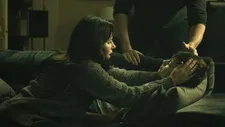 |
| Family crisis |
And then there’s the amazing score, which is the other thing that really drives the film. How did that come about?
“It's written by Steven McKeon, who I've worked with for a while actually, on three of my features and a lot of my short films going back to 2002. He did one for me called Innocence, which was really successful at the Galway Film Fleadh, and he did the original score for the short film Ten Steps as well. And he used some of that in this one. What can I say? I've worked with him for so long. Even when I was editing this time, when I was temping it, I used another one of his scores, for The Hole In The Ground, because it just fitted the atmosphere. And what can I say? You know, when I went to see the first draft he had for me, and I said the second half was great, but elsewhere he was going sort of quiet. And he said, ‘I'm trying to be respectful of the film and some of the dialogue.’ and I said, ‘No, don't, just turn it up to 11. This is not the film to be respectful.’
“I said, ‘We need some dread,’ and there was a thing we used in my very first feature, Savage, and it was this sort of beating, really deep sort of drum move with more and more boom. And he added this in from the start from the opening credits. And the minute he added it in – and it goes through the film a lot – you're on edge. It's just a perfect sound. But look, Steven’s brilliant, and I'll work with him again.”
Aside from the strong emotional effect that all this has in the film, there's also an intellectual dimension to it. How did he go about setting up the puzzle it rests on without overdoing it, and strike the right balance?
“Well, look, in fairness, I am aware that there's a lot of hokum involved with it, right, because it is sort of setting up a cool ending. Really, how do I do it? I'll tell you what, I'd say that I started out with a Judeo Christian sort of mythology that wasn't working. Then over the years, I tried different things. I tried Irish mythology. Balor the king of the Fomorians was in there. It wasn't great. But the minute I realised that I wanted to work with the counting, keep that mathematical thing, I sort of went back to things that I have stored a little bit of or been interested in before, which is possibly the universe” – he laughs – “but was actually fractals and string theory, and I suppose the nearest thing you could say would be an influence would have been HP Lovecraft. Lovecraft’s cosmic power.
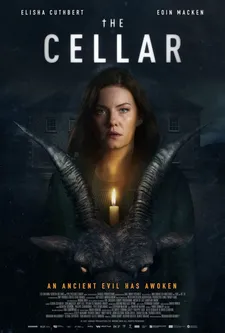 |
| The Cellar poster |
“I actually saw a really interesting comparison from Grimmfest the other day, and they were talking about Nigel Kneale, who I’d forgotten about, and I love Nigel Kneale. So in a way it's sort of really presenting the same things, like the Judeo Christian thing. In my script, what you could call Hell, I call it the Void. I've got a so much backstory, and there were bits cut out with the professor about dimensions and Möbius strips. I have so much stuff that if I could do a sequel, because I have this cult with seven Houses, for the seven Princes of Hell, around Europe, and each one has different symbols in it. Anyway, long story – I could expand on the mythology.”
Does he think he might?
“You know, what? Some of the producers are talking about it, but it does depend on the American release and how it does there. They were saying, look, it doesn't need to break all box office records, plus they were saying they may come back to me. They asked me to do a one pager and I said, ‘Look, if anyone's interested. I'd have a one pager for you overnight, because I have all this stuff. But at the moment I'm working on things and I don't want to have to stop that.
“I'm working on something which is going back toward more of my transgressive domain. Well, it's a revisionist folk horror with Saint Patrick trying to convert a mysterious woman. It's everything I love about horror films. It’s got touches of The Wicker Man, it's got mind bending, psychedelic stuff. It’s ultra violent. It's very transgressive and probably offensive to many Irish. Myself and Conor [Barry], my producer, we're more excited about this than any of the films we’ve done.”





















